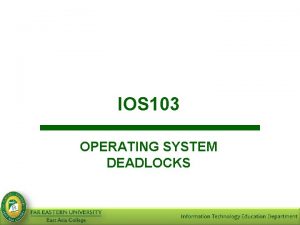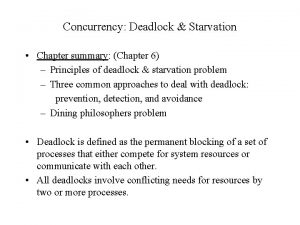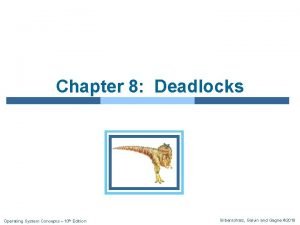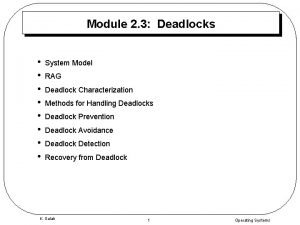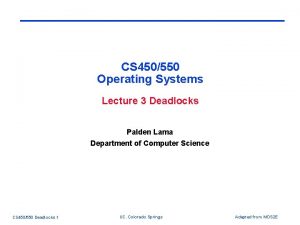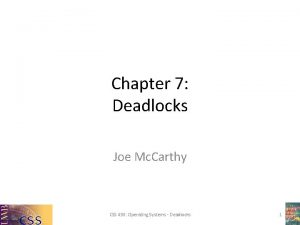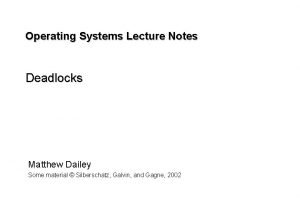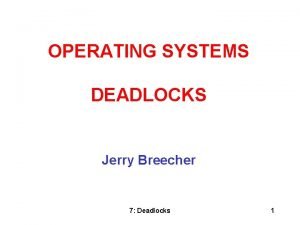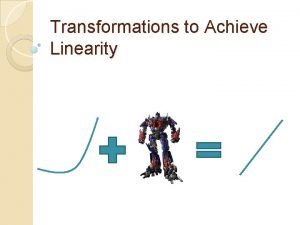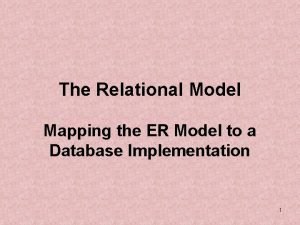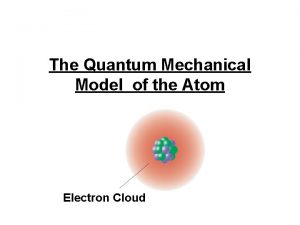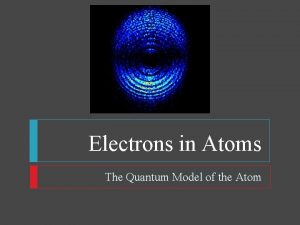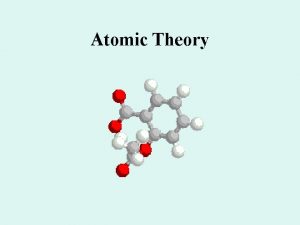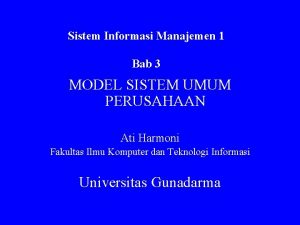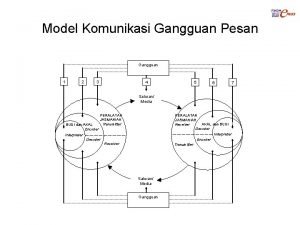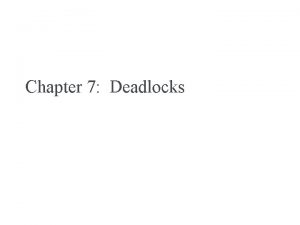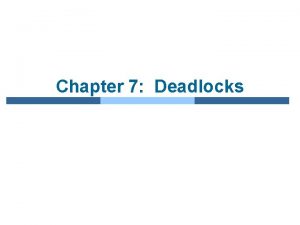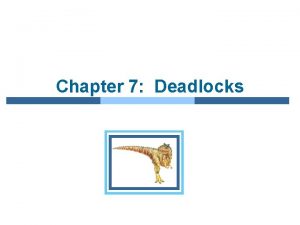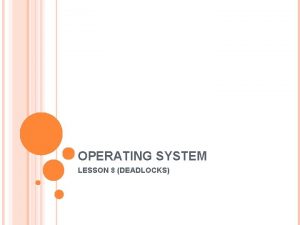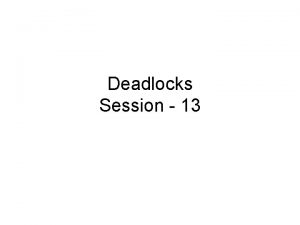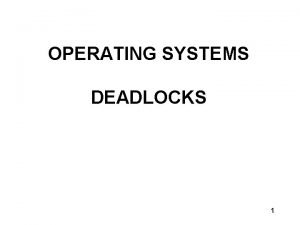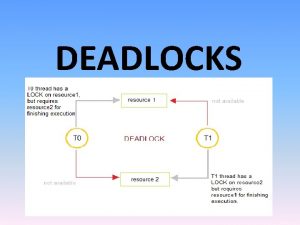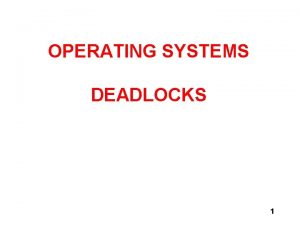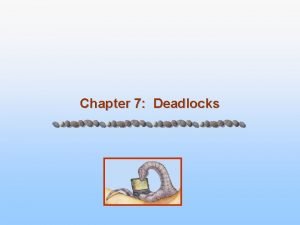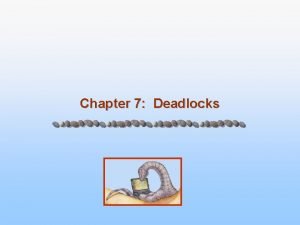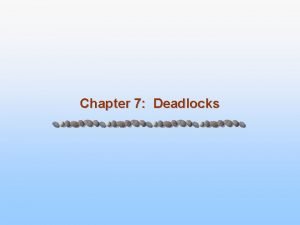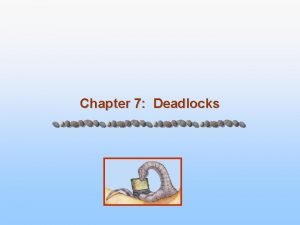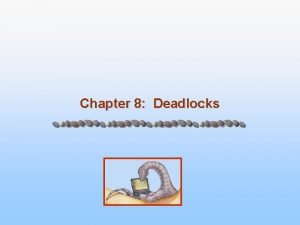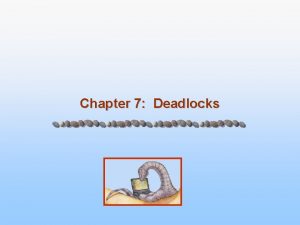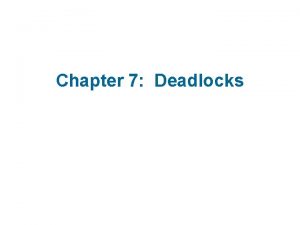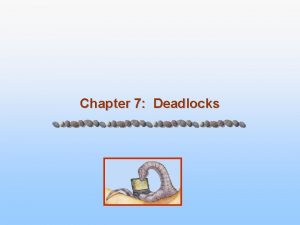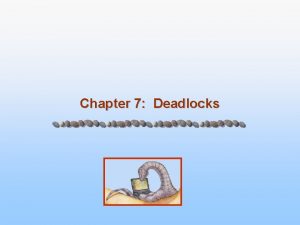Chapter 7 Deadlocks Chapter 7 Deadlocks System Model






































![Detection Algorithm (Cont. ) 3. Work = Work + Allocationi Finish[i] = true go Detection Algorithm (Cont. ) 3. Work = Work + Allocationi Finish[i] = true go](https://slidetodoc.com/presentation_image_h2/3e25a3d9b498928617b667a4ca2dc78a/image-39.jpg)






- Slides: 45

Chapter 7: Deadlocks

Chapter 7: Deadlocks System Model Deadlock Characterization Methods for Handling Deadlocks Deadlock Prevention Deadlock Avoidance Deadlock Detection Recovery from Deadlock

Chapter Objectives To develop a description of deadlocks, which prevent sets of concurrent processes from completing their tasks To present a number of different methods for preventing or avoiding deadlocks in a computer system

System Model System consists of resources Resource types R 1, R 2, . . . , Rm CPU cycles, memory space, I/O devices Each resource type Ri has Wi instances. Each process utilizes a resource as follows: request use release

Deadlock Characterization Deadlock can arise if four conditions hold simultaneously. Mutual exclusion: only one process at a time can use a resource Hold and wait: a process holding at least one resource is waiting to acquire additional resources held by other processes No preemption: a resource can be released only voluntarily by the process holding it, after that process has completed its task Circular wait: there exists a set {P 0, P 1, …, Pn} of waiting processes such that P 0 is waiting for a resource that is held by P 1, P 1 is waiting for a resource that is held by P 2, …, Pn– 1 is waiting for a resource that is held by Pn, and Pn is waiting for a resource that is held by P 0.

Deadlock with Mutex Locks Deadlocks can occur via system calls, locking, etc. See example box in text page 318 for mutex deadlock

Resource-Allocation Graph A set of vertices V and a set of edges E. V is partitioned into two types: P = {P 1, P 2, …, Pn}, the set consisting of all the processes in the system R = {R 1, R 2, …, Rm}, the set consisting of all resource types in the system request edge – directed edge Pi Rj assignment edge – directed edge Rj Pi

Resource-Allocation Graph (Cont. ) Process Resource Type with 4 instances Pi requests instance of Rj Pi is holding an instance of Rj Pi Rj

Example of a Resource Allocation Graph

Resource Allocation Graph With A Deadlock

Graph With A Cycle But No Deadlock

Basic Facts If graph contains no cycles no deadlock If graph contains a cycle if only one instance per resource type, then deadlock if several instances per resource type, possibility of deadlock

Methods for Handling Deadlocks Ensure that the system will never enter a deadlock state: Deadlock prevention Deadlock avoidance Allow the system to enter a deadlock state and then recover Ignore the problem and pretend that deadlocks never occur in the system; used by most operating systems, including UNIX

Deadlock Prevention Restrain the ways request can be made Mutual Exclusion – not required for sharable resources (e. g. , read-only files); must hold for non-sharable resources Hold and Wait – must guarantee that whenever a process requests a resource, it does not hold any other resources Require process to request and be allocated all its resources before it begins execution, or allow process to request resources only when the process has none allocated to it. Low resource utilization; starvation possible

Deadlock Prevention (Cont. ) No Preemption – If a process that is holding some resources requests another resource that cannot be immediately allocated to it, then all resources currently being held are released Preempted resources are added to the list of resources for which the process is waiting Process will be restarted only when it can regain its old resources, as well as the new ones that it is requesting Circular Wait – impose a total ordering of all resource types, and require that each process requests resources in an increasing order of enumeration

Deadlock Example /* thread one runs in this function */ void *do_work_one(void *param) { pthread_mutex_lock(&first_mutex); pthread_mutex_lock(&second_mutex); /** * Do some work */ pthread_mutex_unlock(&second_mutex); pthread_mutex_unlock(&first_mutex); pthread_exit(0); } /* thread two runs in this function */ void *do_work_two(void *param) { pthread_mutex_lock(&second_mutex); pthread_mutex_lock(&first_mutex); /** * Do some work */ pthread_mutex_unlock(&first_mutex); pthread_mutex_unlock(&second_mutex); pthread_exit(0); }

Deadlock Example with Lock Ordering void transaction(Account from, Account to, double amount) { mutex lock 1, lock 2; lock 1 = get_lock(from); lock 2 = get_lock(to); acquire(lock 1); acquire(lock 2); withdraw(from, amount); deposit(to, amount); release(lock 2); release(lock 1); } Transactions 1 and 2 execute concurrently. Transaction 1 transfers $25 from account A to account B, and Transaction 2 transfers $50 from account B to account A

Deadlock Avoidance Requires that the system has some additional a priori information available Simplest and most useful model requires that each process declare the maximum number of resources of each type that it may need The deadlock-avoidance algorithm dynamically examines the resourceallocation state to ensure that there can never be a circular-wait condition Resource-allocation state is defined by the number of available and allocated resources, and the maximum demands of the processes

Safe State When a process requests an available resource, system must decide if immediate allocation leaves the system in a safe state System is in safe state if there exists a sequence <P 1, P 2, …, Pn> of ALL the processes in the systems such that for each Pi, the resources that Pi can still request can be satisfied by currently available resources + resources held by all the Pj, with j < I That is: If Pi resource needs are not immediately available, then Pi can wait until all Pj have finished When Pj is finished, Pi can obtain needed resources, execute, return allocated resources, and terminate When Pi terminates, Pi +1 can obtain its needed resources, and so on

Basic Facts If a system is in safe state no deadlocks If a system is in unsafe state possibility of deadlock Avoidance ensure that a system will never enter an unsafe state.

Safe, Unsafe, Deadlock State

Avoidance Algorithms Single instance of a resource type Use a resource-allocation graph Multiple instances of a resource type Use the banker’s algorithm

Resource-Allocation Graph Scheme Claim edge Pi Rj indicated that process Pj may request resource Rj; represented by a dashed line Claim edge converts to request edge when a process requests a resource Request edge converted to an assignment edge when the resource is allocated to the process When a resource is released by a process, assignment edge reconverts to a claim edge Resources must be claimed a priori in the system

Resource-Allocation Graph

Unsafe State In Resource-Allocation Graph

Resource-Allocation Graph Algorithm Suppose that process Pi requests a resource Rj The request can be granted only if converting the request edge to an assignment edge does not result in the formation of a cycle in the resource allocation graph

Banker’s Algorithm Multiple instances Each process must a priori claim maximum use When a process requests a resource it may have to wait When a process gets all its resources it must return them in a finite amount of time

Data Structures for the Banker’s Algorithm Let n = number of processes, and m = number of resources types. Available: Vector of length m. If available [j] = k, there are k instances of resource type Rj available Max: n x m matrix. If Max [i, j] = k, then process Pi may request at most k instances of resource type Rj Allocation: n x m matrix. If Allocation[i, j] = k then Pi is currently allocated k instances of Rj Need: n x m matrix. If Need[i, j] = k, then Pi may need k more instances of Rj to complete its task Need [i, j] = Max[i, j] – Allocation [i, j]

Safety Algorithm 1. Let Work and Finish be vectors of length m and n, respectively. Initialize: Work = Available Finish [i] = false for i = 0, 1, …, n- 1 2. Find an i such that both: (a) Finish [i] = false (b) Needi Work If no such i exists, go to step 4 3. Work = Work + Allocationi Finish[i] = true go to step 2 4. If Finish [i] == true for all i, then the system is in a safe state

Resource-Request Algorithm for Process Pi Requesti = request vector for process Pi. If Requesti [j] = k then process Pi wants k instances of resource type Rj 1. If Requesti Needi go to step 2. Otherwise, raise error condition, since process has exceeded its maximum claim 2. If Requesti Available, go to step 3. Otherwise Pi must wait, since resources are not available 3. Pretend to allocate requested resources to Pi by modifying the state as follows: Available = Available – Requesti; Allocationi = Allocationi + Requesti; Needi = Needi – Requesti; l If safe the resources are allocated to Pi l If unsafe Pi must wait, and the old resource-allocation state is restored

Example of Banker’s Algorithm 5 processes P 0 through P 4; 3 resource types: A (10 instances), B (5 instances), and C (7 instances) Snapshot at time T 0: Allocation Max Available ABC ABC 010 753 332 P 1 200 322 P 2 302 902 P 3 211 222 P 4 002 433 P 0

Example (Cont. ) The content of the matrix Need is defined to be Max – Allocation Need ABC P 0 743 P 1 122 P 2 600 P 3 011 P 4 431 The system is in a safe state since the sequence < P 1, P 3, P 4, P 2, P 0> satisfies safety criteria

Example: P 1 Request (1, 0, 2) Check that Request Available (that is, (1, 0, 2) (3, 3, 2) true Allocation Need Available ABC ABC P 0 010 743 230 P 1 302 020 P 2 302 600 P 3 211 011 P 4 002 431 Executing safety algorithm shows that sequence < P 1, P 3, P 4, P 0, P 2> satisfies safety requirement Can request for (3, 3, 0) by P 4 be granted? Can request for (0, 2, 0) by P 0 be granted?

Deadlock Detection Allow system to enter deadlock state Detection algorithm Recovery scheme

Single Instance of Each Resource Type Maintain wait-for graph Nodes are processes Pi Pj if Pi is waiting for Pj Periodically invoke an algorithm that searches for a cycle in the graph. If there is a cycle, there exists a deadlock An algorithm to detect a cycle in a graph requires an order of n 2 operations, where n is the number of vertices in the graph

Resource-Allocation Graph and Wait-for Graph Resource-Allocation Graph Corresponding wait-for graph

Several Instances of a Resource Type Available: A vector of length m indicates the number of available resources of each type Allocation: An n x m matrix defines the number of resources of each type currently allocated to each process Request: An n x m matrix indicates the current request of each process. If Request [i][j] = k, then process Pi is requesting k more instances of resource type Rj.

Detection Algorithm 1. Let Work and Finish be vectors of length m and n, respectively Initialize: (a) Work = Available (b) For i = 1, 2, …, n, if Allocationi 0, then Finish[i] = false; otherwise, Finish[i] = true 2. Find an index i such that both: (a) Finish[i] == false (b) Requesti Work If no such i exists, go to step 4
![Detection Algorithm Cont 3 Work Work Allocationi Finishi true go Detection Algorithm (Cont. ) 3. Work = Work + Allocationi Finish[i] = true go](https://slidetodoc.com/presentation_image_h2/3e25a3d9b498928617b667a4ca2dc78a/image-39.jpg)
Detection Algorithm (Cont. ) 3. Work = Work + Allocationi Finish[i] = true go to step 2 4. If Finish[i] == false, for some i, 1 i n, then the system is in deadlock state. Moreover, if Finish[i] == false, then Pi is deadlocked Algorithm requires an order of O(m x n 2) operations to detect whether the system is in deadlocked state

Example of Detection Algorithm Five processes P 0 through P 4; three resource types A (7 instances), B (2 instances), and C (6 instances) Snapshot at time T 0: Request Available ABC ABC P 0 010 P 1 200 P 2 303 000 P 3 211 100 002 P 4 Allocation 000 202 Sequence <P 0, P 2, P 3, P 1, P 4> will result in Finish[i] = true for all i

Example (Cont. ) P 2 requests an additional instance of type C Request ABC P 0 000 P 1 202 P 2 001 P 3 100 P 4 002 State of system? Can reclaim resources held by process P 0, but insufficient resources to fulfill other processes; requests Deadlock exists, consisting of processes P 1, P 2, P 3, and P 4

Detection-Algorithm Usage When, and how often, to invoke depends on: How often a deadlock is likely to occur? How many processes will need to be rolled back? one for each disjoint cycle If detection algorithm is invoked arbitrarily, there may be many cycles in the resource graph and so we would not be able to tell which of the many deadlocked processes “caused” the deadlock.

Recovery from Deadlock: Process Termination Abort all deadlocked processes Abort one process at a time until the deadlock cycle is eliminated In which order should we choose to abort? 1. Priority of the process 2. How long process has computed, and how much longer to completion 3. Resources the process has used 4. Resources process needs to complete 5. How many processes will need to be terminated 6. Is process interactive or batch?

Recovery from Deadlock: Resource Preemption Selecting a victim – minimize cost Rollback – return to some safe state, restart process for that state Starvation – same process may always be picked as victim, include number of rollback in cost factor

End of Chapter 7
 Deadlocks can be described more precisely
Deadlocks can be described more precisely Integrated deadlock strategy
Integrated deadlock strategy Circular wait in operating system
Circular wait in operating system Rag deadlock
Rag deadlock Deadlocks
Deadlocks Deadlocks mc
Deadlocks mc Deadlocks
Deadlocks Resource allocation graph
Resource allocation graph Multiple nuclei model
Multiple nuclei model Is the earth an open or closed system?
Is the earth an open or closed system? Digestive respiratory and circulatory system
Digestive respiratory and circulatory system Taba's grassroots rational model strength and weakness
Taba's grassroots rational model strength and weakness Transforming to achieve linearity
Transforming to achieve linearity Mapping of er model to relational model
Mapping of er model to relational model Quantum mechanical model of atom
Quantum mechanical model of atom Bohr
Bohr Nativization theory explanation
Nativization theory explanation Model tradisional dalam motivasi
Model tradisional dalam motivasi Jenis model
Jenis model Model model pelatihan
Model model pelatihan Motif utama pembuatan model perilaku konsumen adalah
Motif utama pembuatan model perilaku konsumen adalah Model model etika profesi
Model model etika profesi Model pendokumentasian komputer
Model pendokumentasian komputer Jack rothman model
Jack rothman model Cobweb model international relations
Cobweb model international relations Compare and contrast bohr model to quantum model
Compare and contrast bohr model to quantum model Vector vs raster gis
Vector vs raster gis Bohr rutherford diagram
Bohr rutherford diagram Bohr model vs quantum model venn diagram
Bohr model vs quantum model venn diagram Geocentric model vs heliocentric model
Geocentric model vs heliocentric model Osi model vs internet model
Osi model vs internet model Model inovasi pendidikan top down
Model inovasi pendidikan top down Model dokumentasi keperawatan por
Model dokumentasi keperawatan por Abcx model vs double abcx model
Abcx model vs double abcx model Soba model combines the sr model and
Soba model combines the sr model and Analysis model to design model
Analysis model to design model What is difference between geocentric and heliocentric
What is difference between geocentric and heliocentric What is the polis model
What is the polis model Klasifikasi model pengambilan keputusan
Klasifikasi model pengambilan keputusan Model informasi
Model informasi Model-model perilaku abnormal
Model-model perilaku abnormal Organisational behaviour robbins
Organisational behaviour robbins Tyler model advantages and disadvantages
Tyler model advantages and disadvantages Advantages of transactional model of communication
Advantages of transactional model of communication Model pengembangan kurikulum ralph tyler
Model pengembangan kurikulum ralph tyler Message tampering
Message tampering
